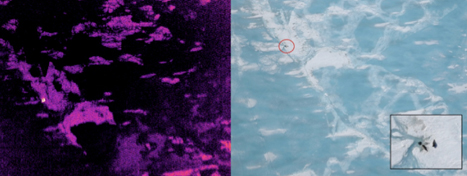Center of Expertise in Marine Mammalogy
Scientific Research Report
2015-2017
Table of Contents
- Complete Text
- Introduction
- Using aerial infrared images to count ringed seals on ice
- The use of unmanned aerial vehicles (UAV)
- 2017: A Marine Mammal Odyssey, Eh!
- Mark-recapture analysis from long-term study on Sable Island identifies changes in demographic rates in northwest Atlantic Grey Seals
- OTN – Using grey seals (Halichoerus grypus) as bioprobes to estimate phytoplankton biomass
- Northwest Atlantic International Sightings Survey (NAISS) of Marine Megafauna on the Continental Shelf From Northern Labrador to the Bay of Fundy
- Monitoring Movements of Whelping Seals on Drifting Pack Ice
- Marine Mammal Genomics Research in the Central and Arctic Region
- OTN and predator-prey interactions
- Listening in on the Deep: Passive Acoustic Monitoring of Whales off Nova Scotia
- Sharing Meals Keeps Killer Whale Families Together: Provisioning relatives maintains long-term social bonds and helps pass on shared genes
- New developments in the use of fatty acids to determine marine mammal diets
- More than a mouthful – unlocking bowhead whale foraging and reproductive histories from baleen
- Observing walrus behaviour at haulout sites in quasi real-time
- Moving towards automated counting
- References
Using aerial infrared images to count ringed seals on ice
Brent Young and Steve Ferguson
Estimating marine mammal abundance for stock assessment is challenging. The ability of visual observers seated in moving aircraft to reliably detect animals is limited. Although line transect methods can be employed to account for undetected animals, these methods have considerable uncertainty associated with them. Double -platform line transect methods are based on a number of key assumptions that require at least four observers and detailed statistical analysis to estimate and control for bias. To overcome these limitations, aerial and satellite imagery is being used more and more on marine mammal surveys to try to improve estimates by reducing the number of missed animals. However, in the absence of reliable automated detection methods, analysis of aerial survey photographs is very time consuming and is not always practical.

Aerial view of two ringed seal hauled out on the sea-ice in Eclipse Sound in June 2016. Images were taken with an infrared camera (left) and a digital single lens reflex camera (right). Inset shows a close up view of the seals (photos: DFO).
For surveys of seals on ice, recent advances in infrared technology offer one solution to both improve density estimation while reducing human resource needs in conducting surveys and analyzing photographs. To conduct surveys of ringed seals on ice we used a high resolution infrared (IR) camera (FLIR T1030sc) paired with a high resolution digital single lens reflex (DSLR) camera (Nikon D810). Ice seals in the Arctic, like ringed and bearded seals, haul out on ice in spring to molt (change their fur) and are available to be observed from overhead aircraft conducting surveys. When the seals are hauled out on the sea ice, the warmth of their bodies is contrasted against the cold surface of the ice and appears as an obvious ‘hot spot’ in the infrared imagery (see photos). Infrared video files were analysed to identify hot spots of potential seals and the corresponding photographs from the DSLR were checked to verify observations. Using these methods, seals can be efficiently detected with a high level of confidence, meeting the key assumptions of strip-transect analysis and providing considerable advantages over traditional methods. Fisheries and Oceans Canada continues to develop these new methods to allow for more efficient abundance estimation as conservation efforts call for greater frequency and coverage of marine mammal stocks in order to improve assessment.
- Date modified: